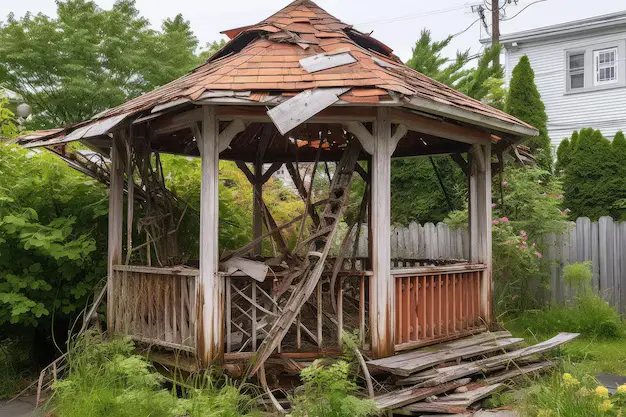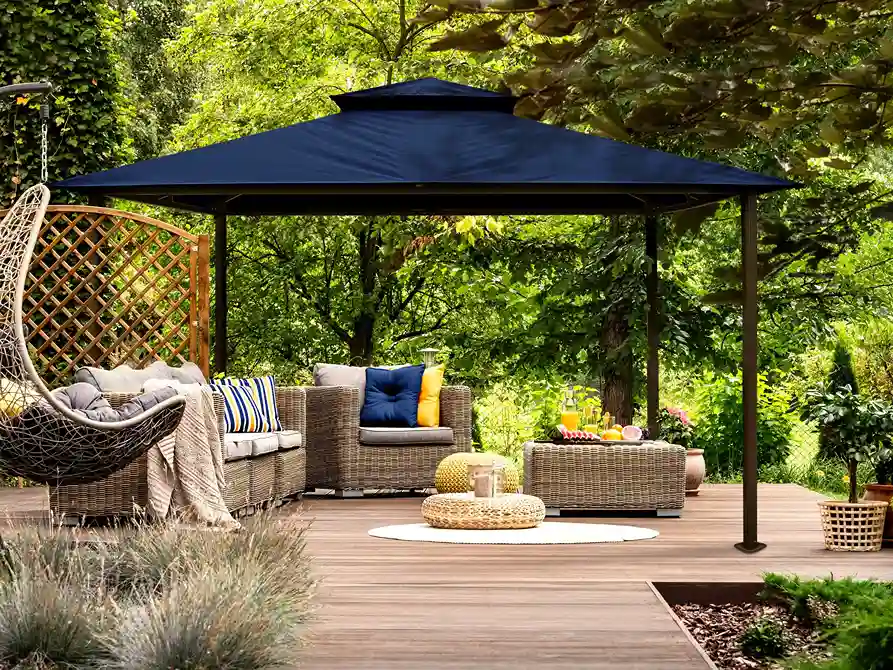When it comes to enjoying your backyard, a gazebo adds a touch of elegance and creates a beautiful focal point. But, are gazebos covered by insurance?
However, understanding whether your homeowners’ insurance covers your gazebo is crucial for your peace of mind. This article delves into the ins and outs of insurance coverage for gazebos, so you’re well-informed.

Contents
- 1 Are Gazebos Covered by Insurance?
- 2 Coverage Types and Gazebos
- 3 Factors Affecting Gazebo Insurance Coverage
- 4 How to Check if Your Gazebo is Covered?
- 5 Increasing Coverage for Your Gazebo
- 6 Filing a Claim for Gazebo Damage
- 7 Pro Tips: Maximizing Your Gazebo’s Insurance Coverage
- 8 Common Misconceptions About Gazebo Insurance Coverage
- 9 Tips for Selecting the Right Insurance Policy for Gazebos
- 10 Frequently Asked Questions (FAQs)
Are Gazebos Covered by Insurance?
A gazebo is seen as a detached structure in the eyes of home insurance providers. Often, it falls under the category of ‘Other Structures‘ in a homeowners’ insurance policy. This means it’s typically covered, but only to a certain extent.
Coverage Types and Gazebos
Your gazebo stands against various potential risks, from harsh weather to unforeseen vandalism. Most standard homeowners’ policies offer coverage for such incidents.
However, it’s important to note that while your gazebo might be covered for a tree falling during a storm, it may not be protected against all risks. Always check what events are covered.
Factors Affecting Gazebo Insurance Coverage
The material of your gazebo can significantly influence your insurance coverage. Gazebos made of durable materials might enjoy lower premiums.
Additionally, the value of your gazebo plays a role. High-end structures may require additional insurance.
The location of your gazebo within your property can also affect coverage. Structures closer to the main house may have different coverage levels than those at the boundary of your property.
How to Check if Your Gazebo is Covered?
Reviewing your insurance policy is the best way to determine if your gazebo is covered. Look for the section on ‘Other Structures’ and see what’s included. If the information isn’t clear, a call to your insurance provider can clarify your gazebo’s coverage status.
Increasing Coverage for Your Gazebo
If you find your gazebo’s coverage insufficient, consider purchasing additional insurance. A rider or an add-on to your current policy might be all you need. Speaking with an insurance agent can provide options best suited to your needs.
Filing a Claim for Gazebo Damage
Should your gazebo suffer damage, filing a claim involves several steps. First, document the damage thoroughly. This can be pivotal in the claims process.

Next, review your insurance policy again to understand the covered risks. Then, reach out to your insurance provider to start the claims process. They will guide you through the necessary steps.
Pro Tips: Maximizing Your Gazebo’s Insurance Coverage
To ensure you’re fully covered, routine maintenance on your gazebo is essential. It can prevent minor issues from turning into major problems. Keep a record of all repairs and upgrades.
This information can be invaluable during the insurance claims process. Additionally, reviewing your policy annually ensures that your coverage keeps pace with any changes to your gazebo or your overall insurance needs.
Common Misconceptions About Gazebo Insurance Coverage
When it comes to insurance coverage for gazebos, several myths and misconceptions can lead homeowners astray. A prevalent misunderstanding is that gazebos, being outside the main house, are not covered by standard homeowners’ insurance policies.
In reality, most policies consider gazebos as “Other Structures” and offer some degree of coverage. Another common fallacy is the belief that all damages, regardless of cause, are covered.
However, coverage varies significantly based on the specific perils outlined in your policy, such as storms, fire, or vandalism, but may exclude others like floods or earthquakes without additional coverage.
Additionally, there’s a misconception about the replacement value; some believe insurance will always cover the full cost to replace a damaged gazebo, but actual coverage may be based on the structure’s current value, factoring in depreciation.
Understanding these nuances is crucial to ensure that you’re adequately protected and not caught off guard.
You May Also Find Useful: Can A Gazebo Be Used For A Backyard Office? | How To Keep Water From Pooling On Gazebo?
Tips for Selecting the Right Insurance Policy for Gazebos
Choosing the correct insurance policy for a gazebo is key to ensuring that you are appropriately covered without paying for unnecessary extras. Here are some targeted tips to help homeowners make informed decisions:

- Understand Coverage Limits: Ensure the policy provides adequate coverage by understanding the limits and what percentage of your total homeowner’s policy is allocated for “Other Structures” like gazebos. Typically, this is about 10% of the dwelling coverage but may vary depending on the insurer.
- Check for Specific Perils Covered: Review which perils are included in the coverage, such as wind, fire, or vandalism. Be mindful that common risks specific to your area (e.g., floods or earthquakes) might require additional riders or a separate policy.
- Deductibles and Premiums: Evaluate the cost-effectiveness of your policy. A lower premium might come with a higher deductible, which could be costly in the event of damage. Find a balance that fits your financial situation.
- Ask About Depreciation vs. Replacement Cost: Understand whether the policy offers actual cash value (depreciation considered) or replacement cost coverage for structures like your gazebo. Replacement cost coverage is typically preferred as it does not consider depreciation.
- Review Policy Exclusions: Be aware of any exclusions that may apply to detached structures. Some policies might exclude specific materials or unique features of a gazebo.
- Bundle for Discounts: Look into multi-policy discounts if you bundle your home’s main policy with other structures or different types of insurance from the same provider.
By focusing on these aspects, you can not only tailor your gazebo’s coverage to meet specific needs but also manage your insurance costs effectively.
Frequently Asked Questions (FAQs)
Are there different types of gazebos that affect insurance coverage?
Yes, the construction material and purpose (personal vs. commercial use) can affect how insurance companies view and cover gazebos.
Does the purpose of the gazebo (personal vs. commercial) affect coverage?
Absolutely. Gazebos used for commercial purposes may require a separate policy or additional coverage due to the increased liability risk.
How can I reduce the insurance costs for my gazebo?
Choosing durable materials and ensuring proper maintenance can help lower insurance costs. Additionally, discussing your specific situation with your insurance agent can reveal more ways to save on premiums.
Conclusion:
Most homeowners’ insurance policies cover gazebos, but coverage can vary widely. Understanding your policy’s specifics is essential to ensure your gazebo is adequately protected.
Don’t hesitate to reach out to your insurance provider for clarification or to explore additional coverage options. A little diligence goes a long way in protecting your lovely backyard retreat.
Understanding your homeowner’s insurance coverage for structures like gazebos helps you enjoy your outdoor space with peace of mind. Be proactive about your coverage, and you’ll ensure that your gazebo remains a place of relaxation and joy for years to come.

Sergio Gomes, a passionate advocate for outdoor living and the male voice behind Shades Authority. With years of experience, Sergio is your trusted source for expert insights on gazebos, pavilions, cabanas, pergolas, and all things outdoor shade solutions. Join him on a journey to transform your outdoor spaces into stunning, functional retreats
